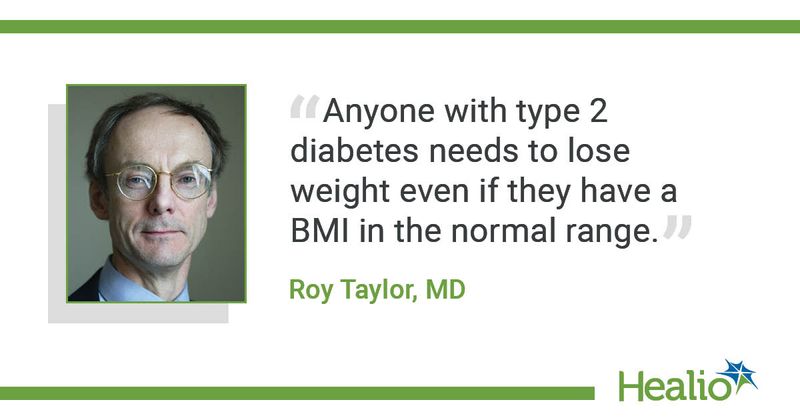Weight loss may help adults achieve type 2 diabetes remission, irrespective of BMI
Click Here to Manage Email Alerts
Adults with normal weight and type 2 diabetes may be able to achieve diabetes remission with weight loss, according to data presented at the European Association for the Study of Diabetes virtual meeting.
In an analysis of data from the ReTUNE trial, two-thirds of adults with diabetes and a BMI of less than 27 kg/m2 were able to achieve diabetes remission after participating in a weight-loss intervention. The proportion was similar to those of previous studies analyzing diabetes remission with weight loss for people with overweight or obesity. Additionally, the study cohort had similar pathophysiologic changes during remission as previous studies showed for people with overweight and obesity.

“It is assumed by many people that type 2 diabetes is a disease of obesity,” Roy Taylor, MD, professor of medicine and metabolism at Newcastle University, United Kingdom, told Healio. “But now that we know exactly what causes the disease — a small excess of fat stored inside the liver and pancreas — we can ask whether the cause is the same in people who have type 2 diabetes, but are not overweight. The bottom line is that everyone has a personal fat threshold, and if this is exceeded, then diabetes may happen. Some people have a very low threshold, and so they can get type 2 diabetes with only a few kilograms of weight gain. We now show from these preliminary results that this can be put into remission by losing that weight.”
Lower HbA1c, glucose after weight loss
In ReTUNE, researchers analyzed data from 12 adults with type 2 diabetes and normal weight (mean age, 58.3 years; mean BMI, 24.5 kg/m2). The cohort was matched by age, sex and BMI with a control group without diabetes. The group with diabetes was enrolled in a weight-loss program in which they consumed 800 kcal per day for 2 weeks, followed by 4 to 6 weeks of support to maintain the new weight. Participants completed up to three rounds of the diet and weight maintenance cycle until they lost 10% to 15% of their body weight. Intra-organ fat was measured by 3-point Dixon magnetic resonance. Diabetes remission was defined as having an HbA1c of less than 48 mmol/mol, or 6.5%, without medication.
Mean fasting glucose decreased from 7.3 mmol/L at baseline to 6.3 mmol/L after weight loss, and mean HbA1c dropped from 53.8 mmol/mol (7.1%) to 48 mmol/mol (6.5%). Fasting plasma insulin dropped from 52.2 pmol/L at baseline to 23.7 pmol/L after weight loss (P = .007). Participants also reduced total body fat from baseline to post-intervention (33.1% vs. 27.4%; P < .001) and had a decrease in plasma triglyceride (1.6 mmol/L to 1 mmol/L; P = .002). No change was observed in non-esterified fatty acids.
Mechanisms behind diabetes remission
The type 2 diabetes cohort had more than twice as much liver fat at baseline as the control group (4.4% vs. 1.9%; P = .02). After the intervention, liver fat among the diabetes group dropped to a mean of 1.4%. Similarly, the intervention group had a reduction in pancreas fat from 5.1% at baseline to 4.5% after weight loss, closer to the control group’s mean pancreas fat of 3.4%. Of the 12 participants in the intervention, eight achieved diabetes remission. Taylor said the reductions in liver and pancreas fat allowed normal function of these organs to return and allowed most of the study cohort to reach remission.
“In the liver, the excess fat prevents insulin from working properly, and blood sugar levels are pushed up,” Taylor said. “In the pancreas, the excess fat causes the insulin-producing cells to not be able to increase production after meals, so sugar levels shoot up to very high levels.”
Taylor said the findings reveal how weight loss could be a critical intervention tool for people with type 2 diabetes.
“Doctors and nurses need to know that anyone with type 2 diabetes needs to lose weight even if they have a BMI in the normal range,” Taylor said.

